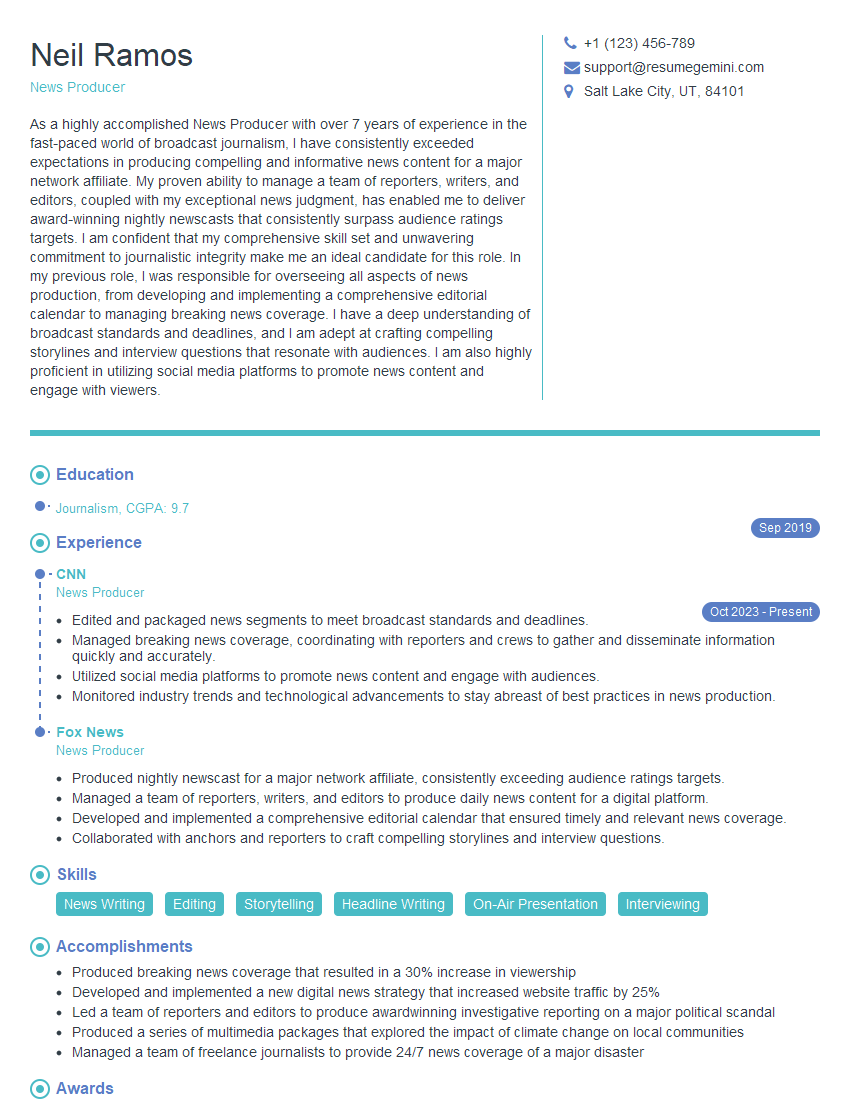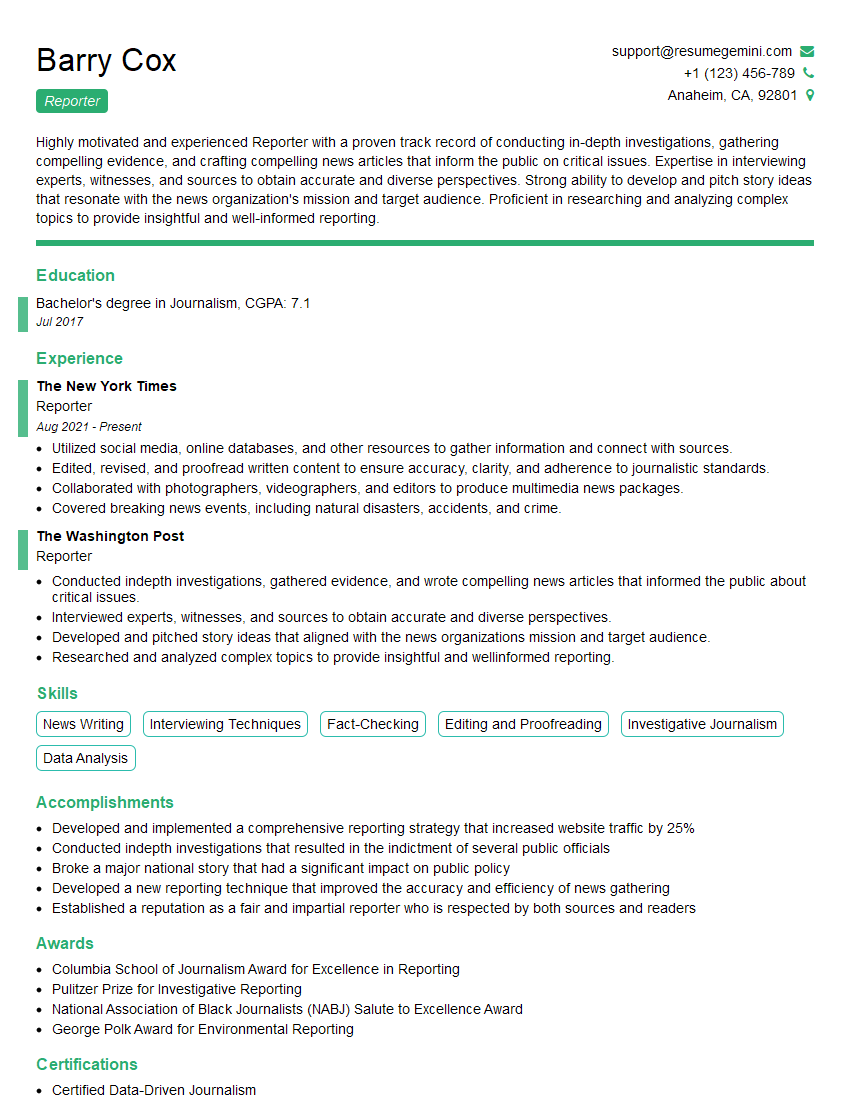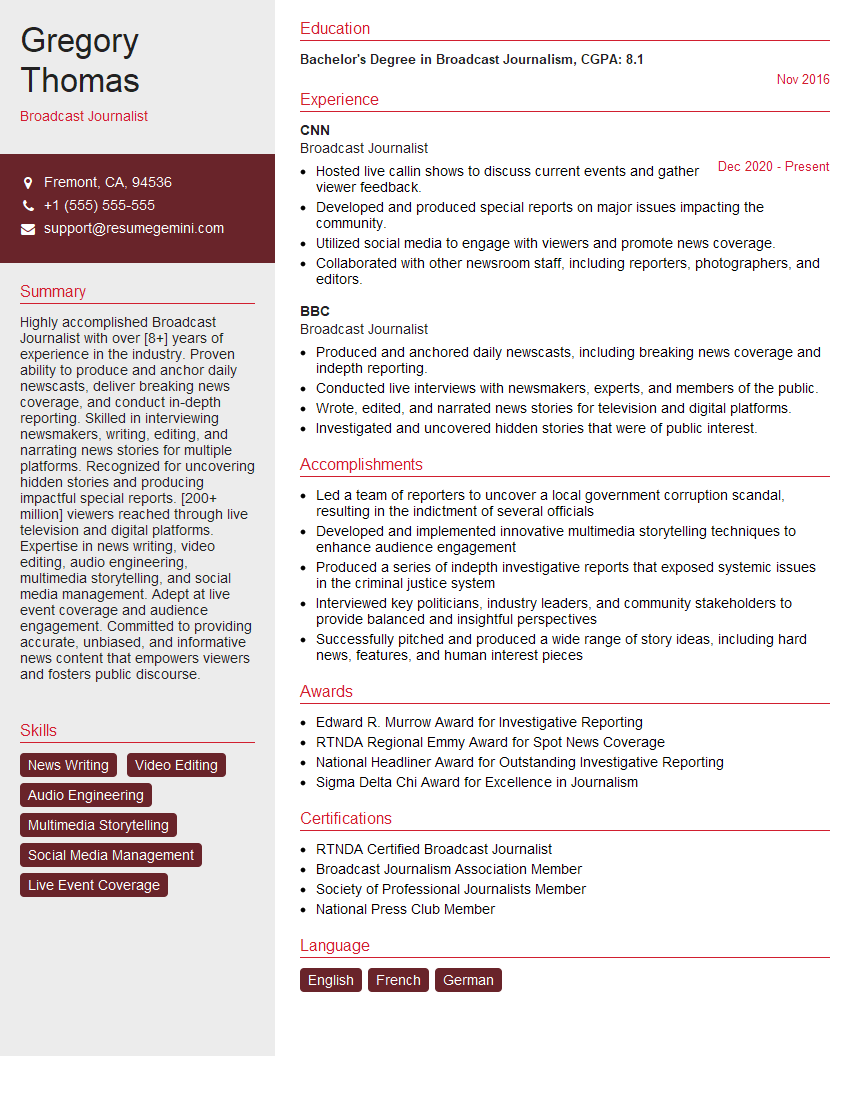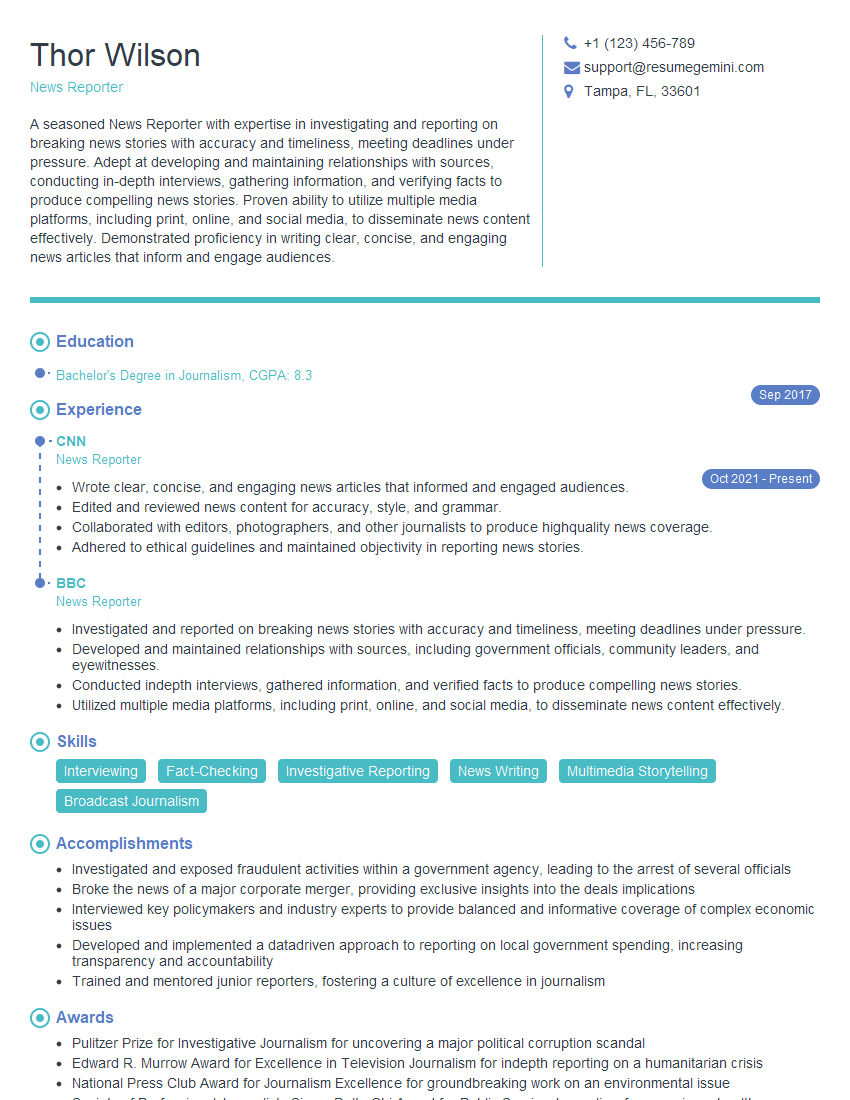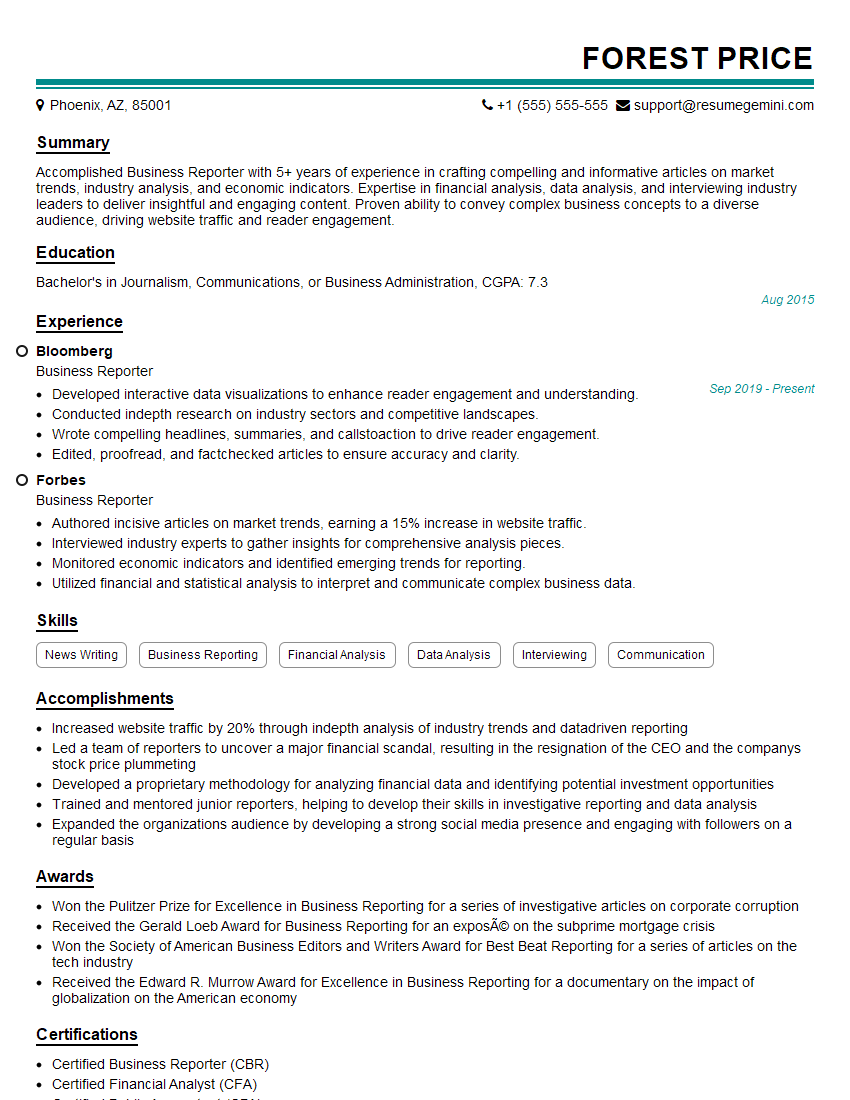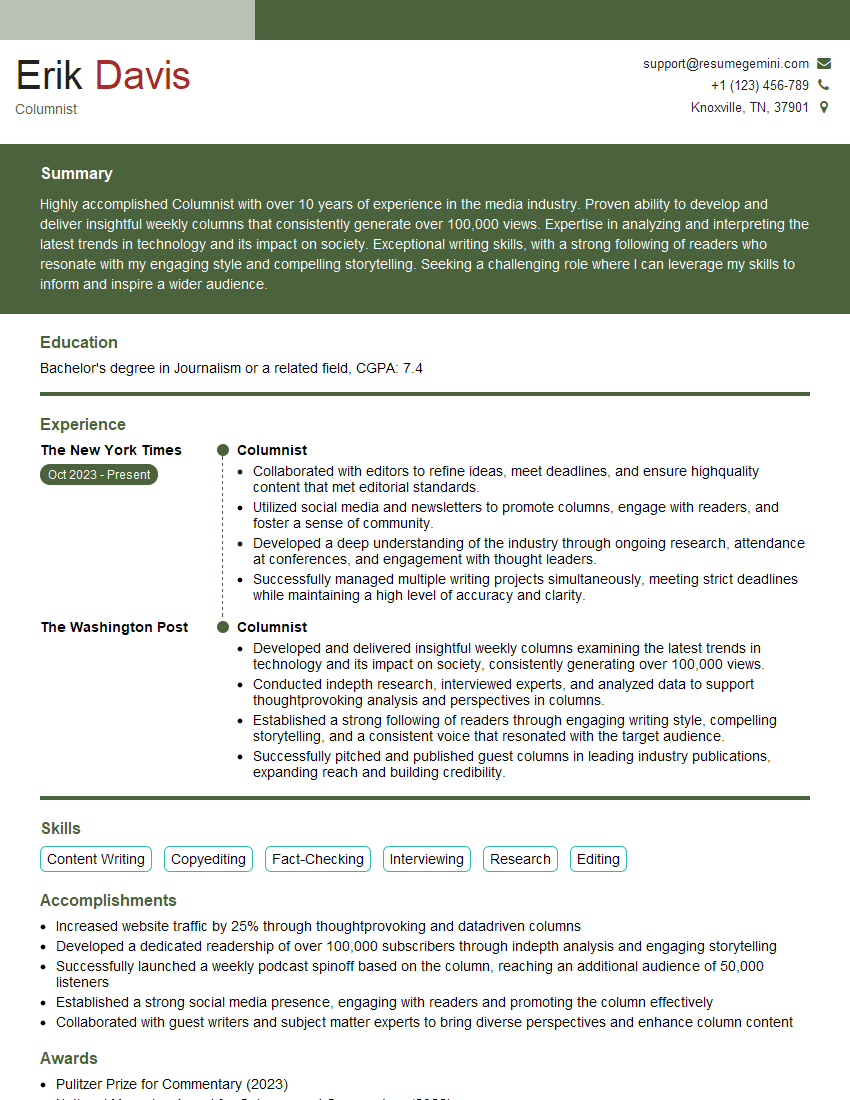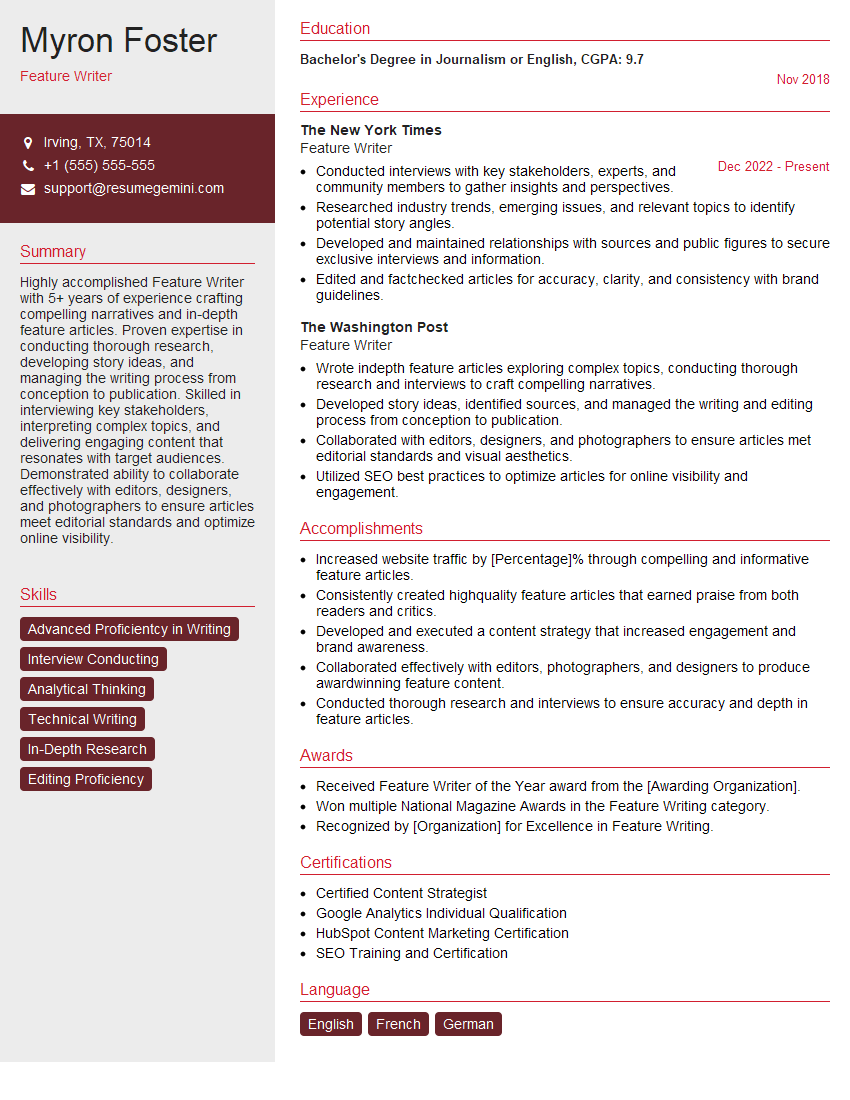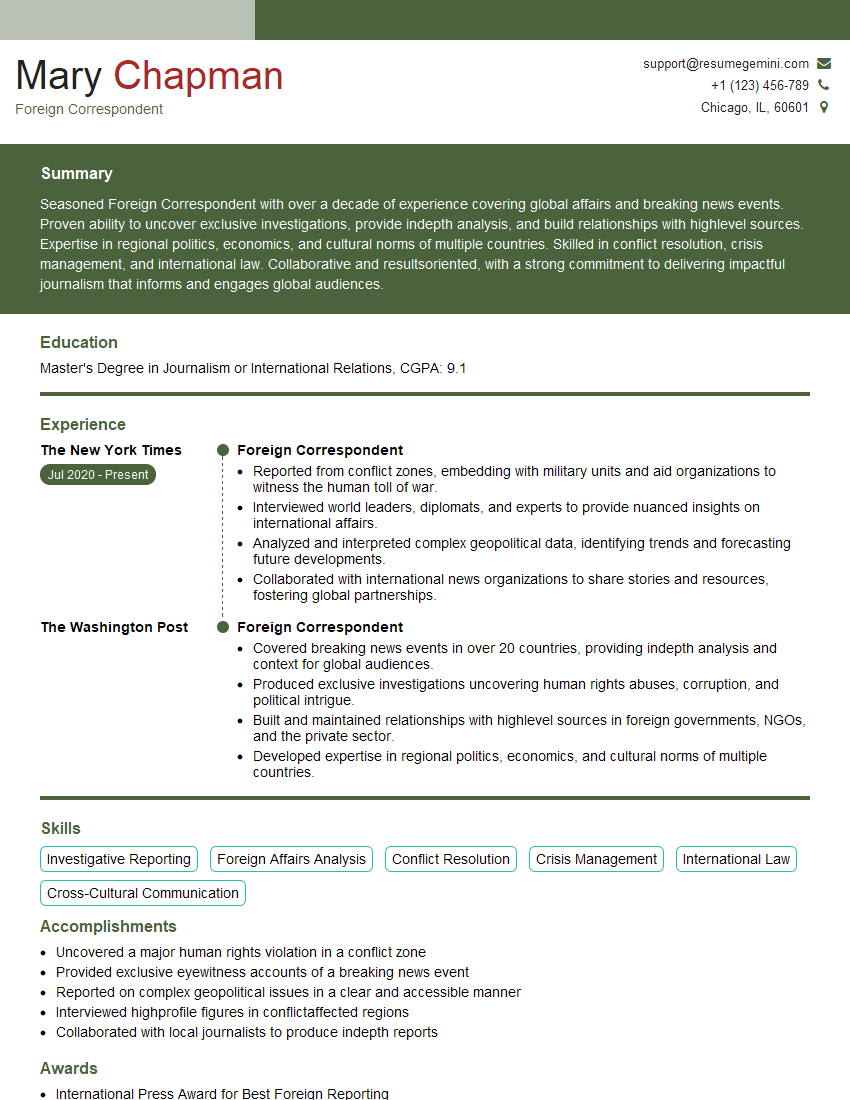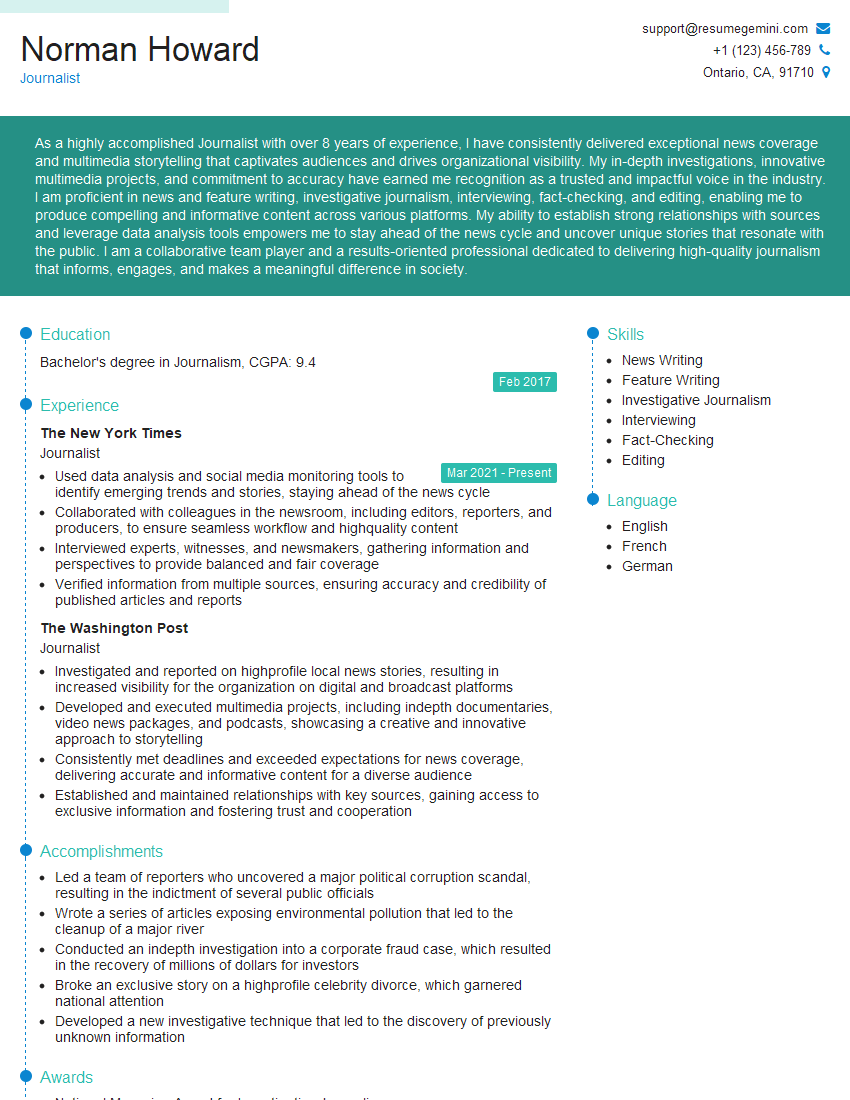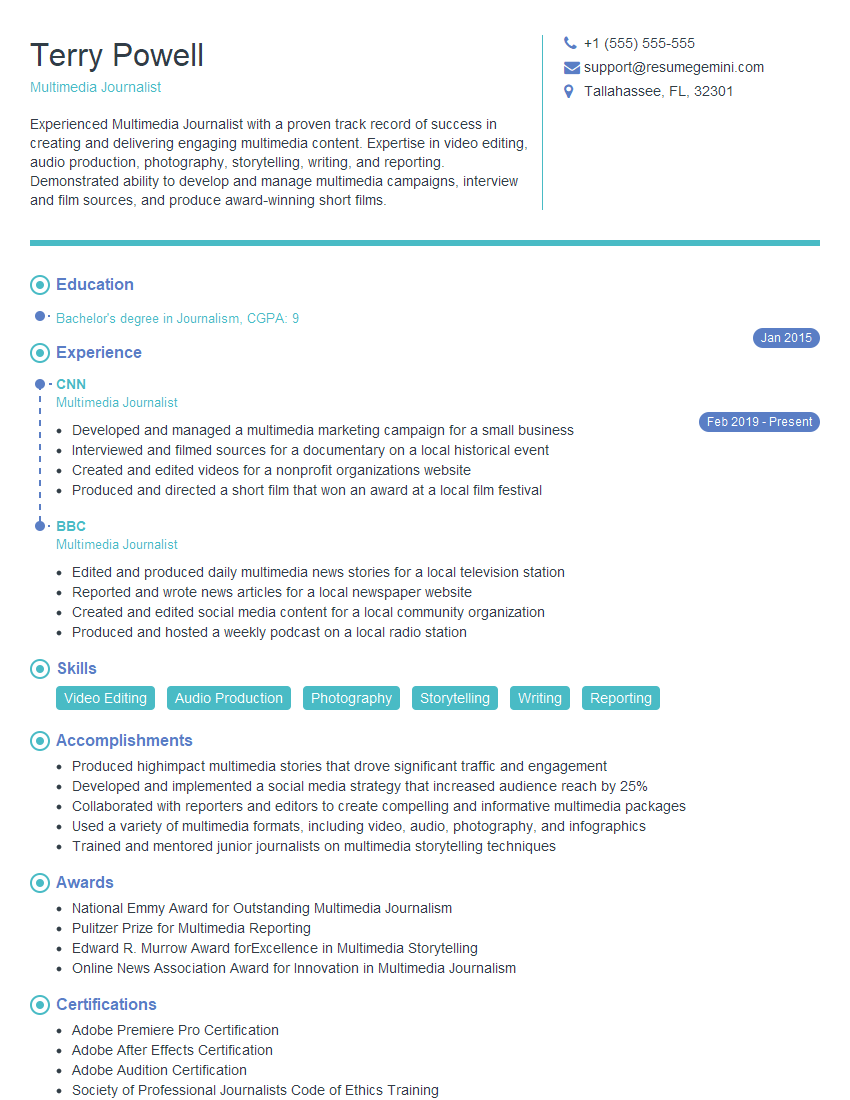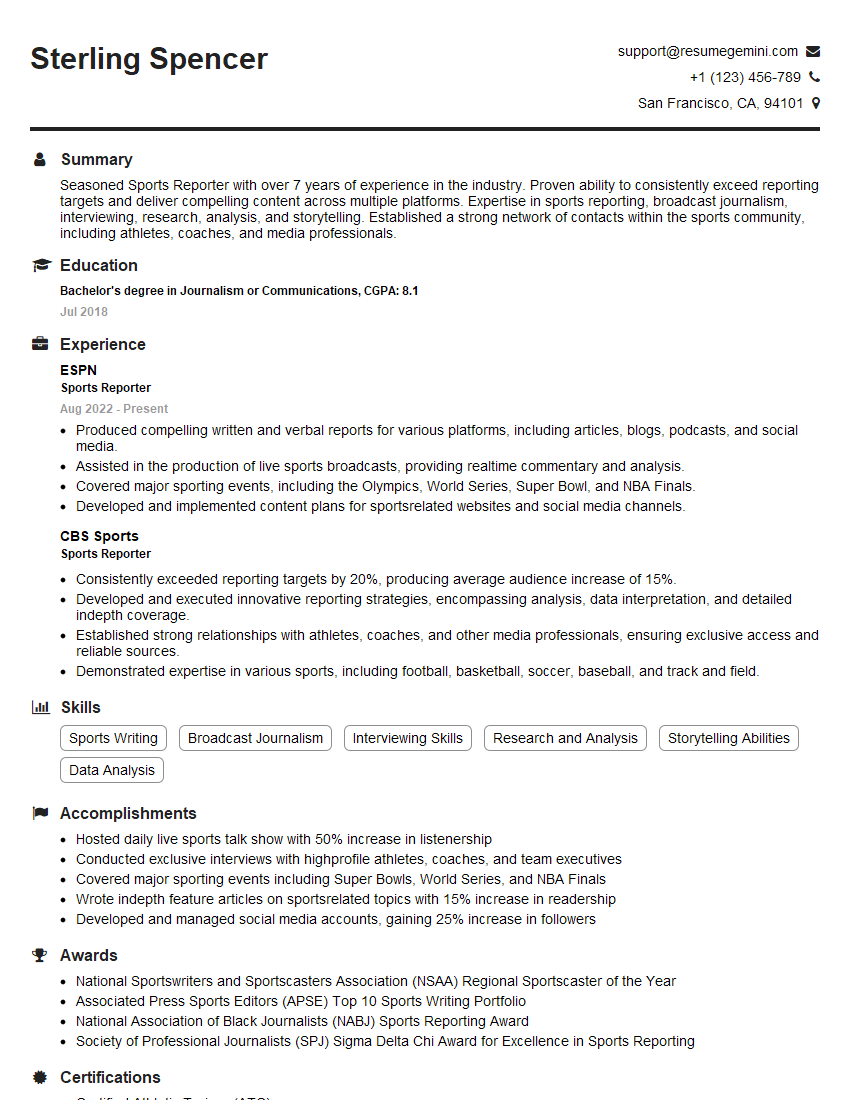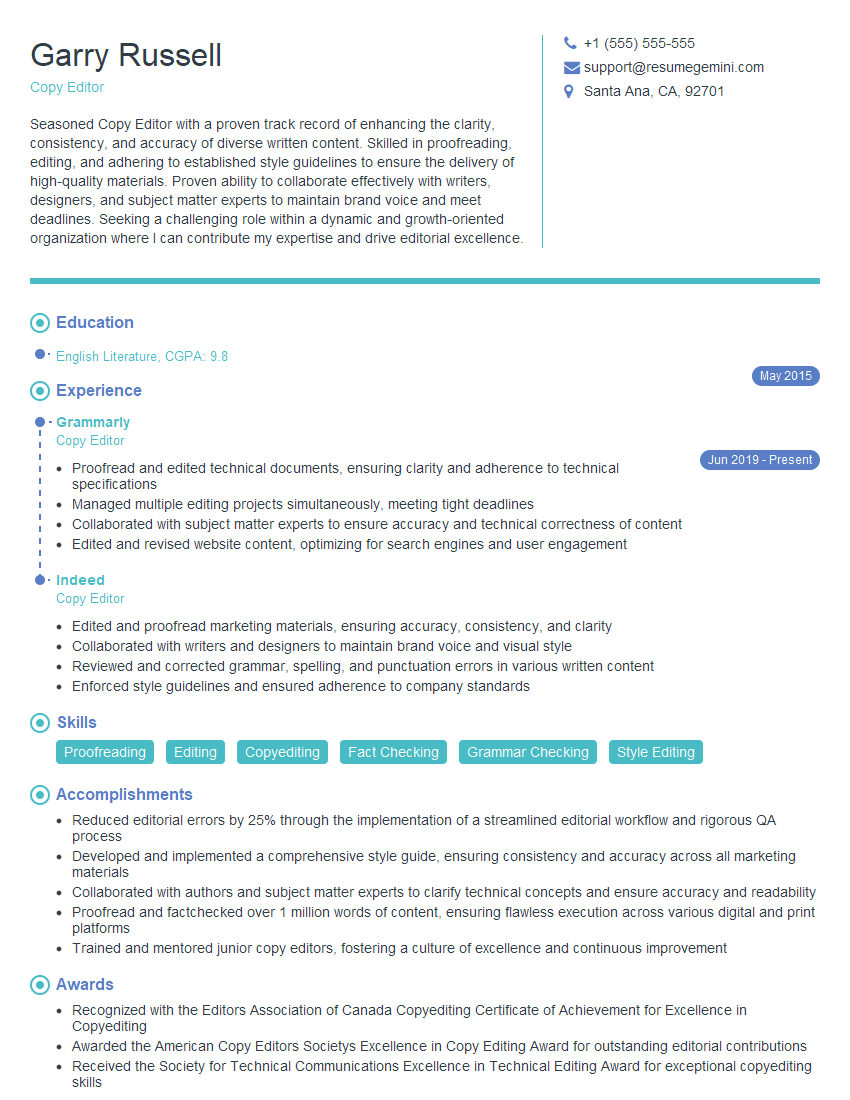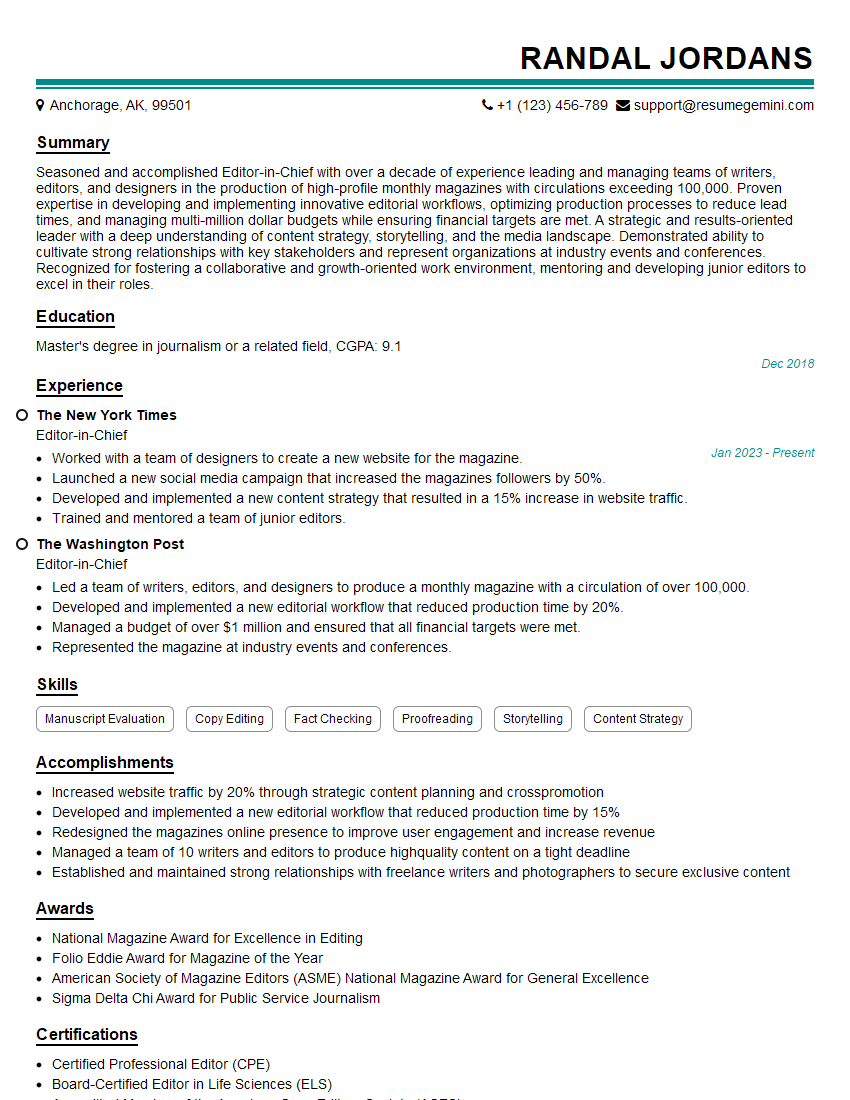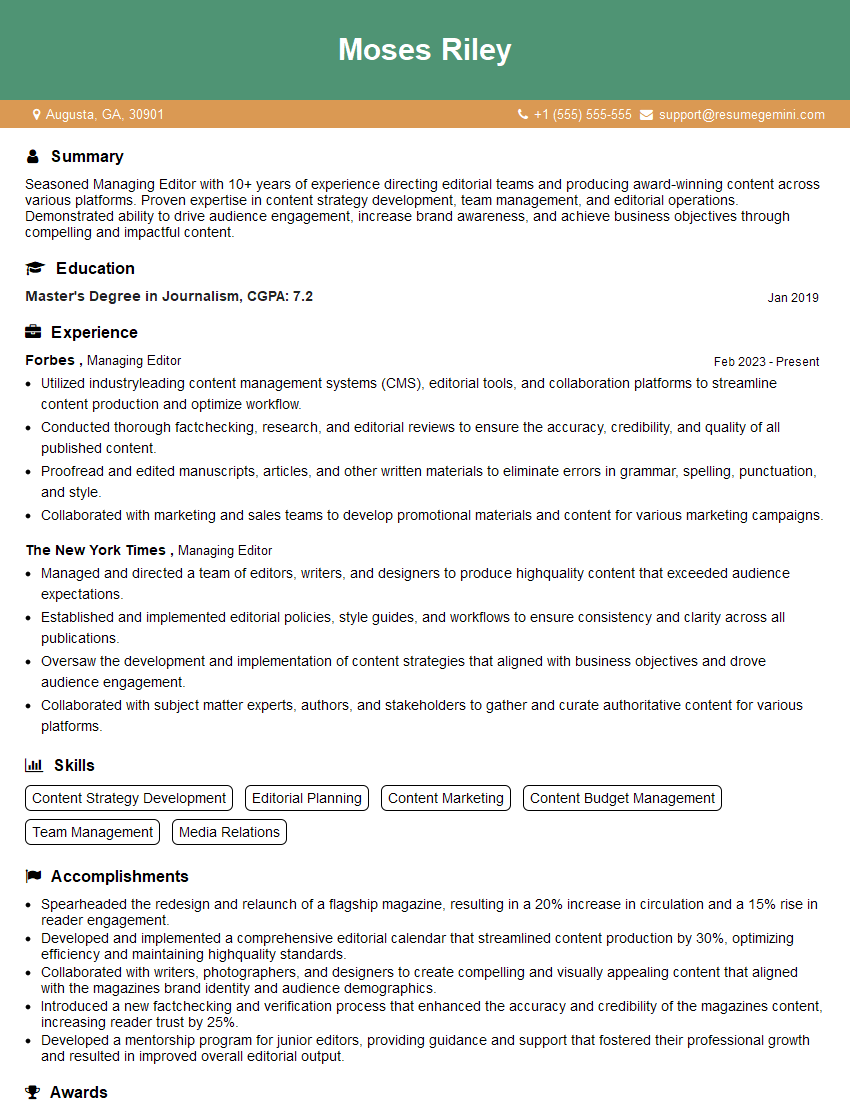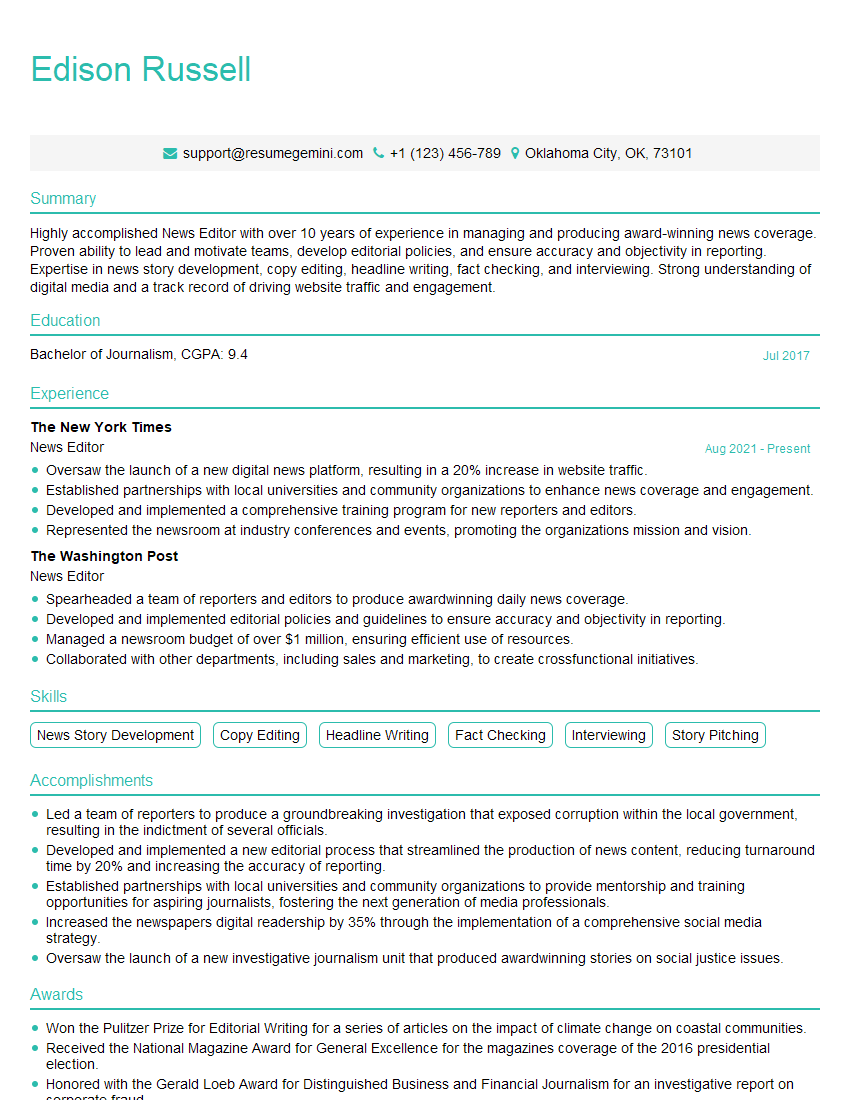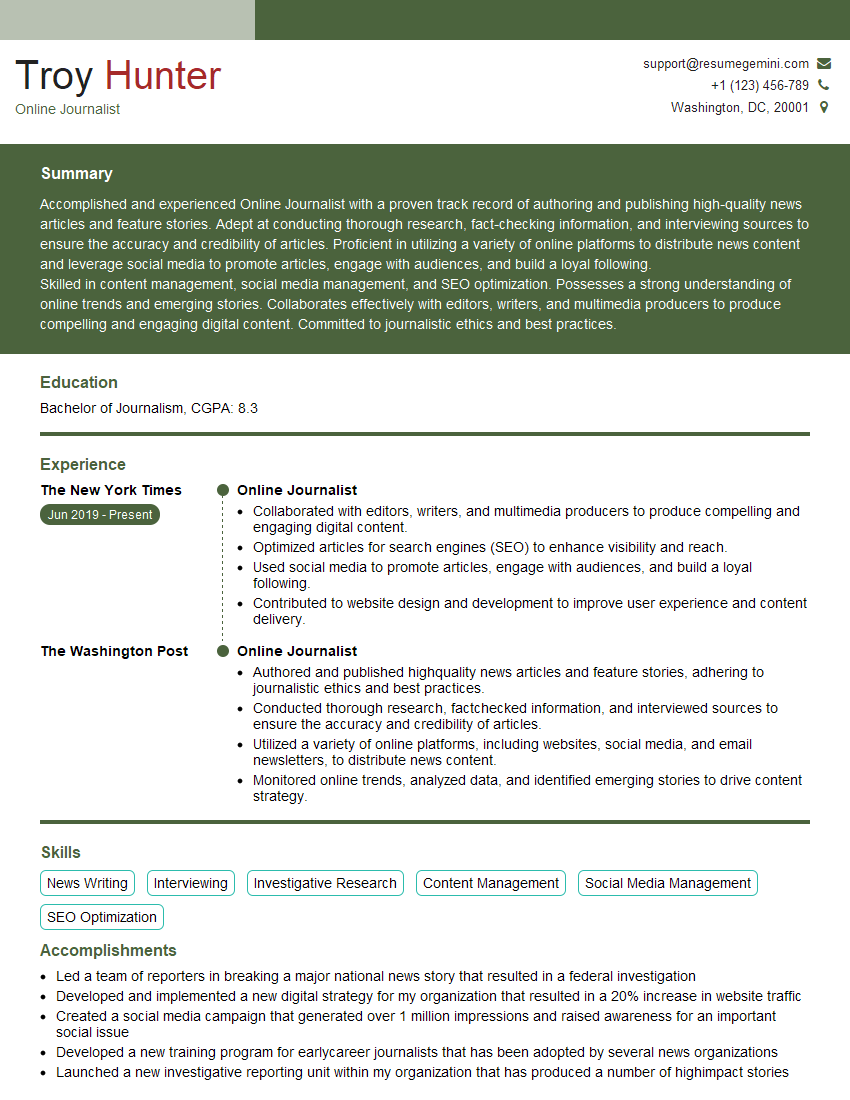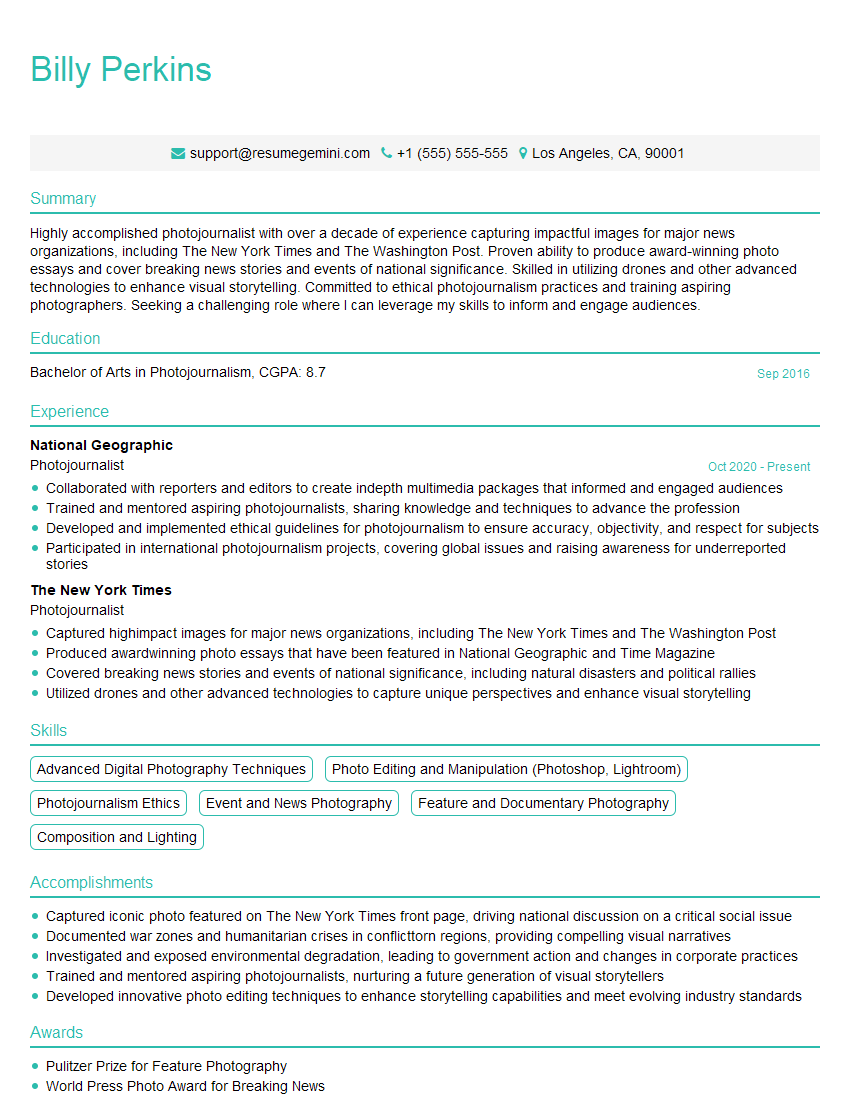Interviews are opportunities to demonstrate your expertise, and this guide is here to help you shine. Explore the essential Journalism and Reporting interview questions that employers frequently ask, paired with strategies for crafting responses that set you apart from the competition.
Questions Asked in Journalism and Reporting Interview
Q 1. Explain the difference between objective and subjective reporting.
Objective reporting presents information in a neutral and unbiased manner, focusing on facts and avoiding personal opinions or interpretations. Subjective reporting, conversely, incorporates the reporter’s perspective, opinions, and interpretations alongside the facts. Think of it like this: objective reporting is like a scientific experiment – you present the data without drawing conclusions; subjective reporting is like writing a movie review – your opinion is central to the piece.
Example: An objective report on a political rally would simply state the number of attendees, the speakers’ key points, and any significant events. A subjective report might analyze the rally’s success based on the reporter’s interpretation of the crowd’s enthusiasm and the impact of the speeches.
Q 2. Describe your experience with fact-checking and verification techniques.
Fact-checking is the cornerstone of credible journalism. My process involves multiple layers of verification. I begin by cross-referencing information from multiple reputable sources. This could include official documents, government websites, expert interviews, and peer-reviewed studies. I then scrutinize the information for inconsistencies, biases, or potential misinformation. If necessary, I conduct further research or seek clarifications from sources. Techniques I frequently employ include reverse image searches to check for manipulated photos, analyzing metadata for authenticity and source information, and verifying information using open-source intelligence (OSINT) tools.
Example: Recently, while writing a story about a local business, I found conflicting claims about their revenue. Instead of accepting either claim at face value, I obtained their financial statements (with consent), examined their business registration documents, and interviewed industry analysts to corroborate the data.
Q 3. How do you handle conflicting information from multiple sources?
Handling conflicting information requires a systematic approach. First, I assess the credibility of each source, considering their expertise, potential biases, and track record. Then, I look for corroborating evidence from independent sources. I identify the points of disagreement and investigate them thoroughly. This may involve interviewing additional experts, examining primary source documents, or using fact-checking tools. If the conflict remains irresolvable, I acknowledge the discrepancy in my reporting and explain the uncertainty to the reader.
Example: While reporting on a controversial scientific study, I encountered contrasting opinions from leading researchers. I interviewed multiple experts, analyzed the raw data, and included the opposing perspectives, clearly explaining the reasons for the disagreement to provide a comprehensive and unbiased picture.
Q 4. What is your process for writing a compelling news story?
Writing a compelling news story involves a structured process. It starts with a strong lead that grabs the reader’s attention and sets the tone. Then, I develop the narrative, using a logical structure – often the inverted pyramid for hard news – providing the most important information first. I incorporate supporting evidence, quotes from credible sources, and descriptive details to paint a vivid picture. Throughout the writing process, I maintain clarity, accuracy, and conciseness. Finally, a strong conclusion summarizes the key takeaways and leaves a lasting impression.
Example: For a story on a local community project, I started with an anecdote highlighting the impact of the project on a specific individual. I then presented the facts and figures, incorporating quotes from the project organizers and community members. I concluded with a reflection on the project’s success and future potential.
Q 5. How do you prioritize news stories under tight deadlines?
Prioritizing news stories under tight deadlines requires a strategic approach. I assess the news value of each story using factors like timeliness, impact, proximity, and prominence. I identify the stories with the greatest immediate impact and urgency. This often involves a process of elimination, making tough decisions about which stories to cover fully and which to summarize or postpone. Collaboration with editors and other journalists is crucial in efficiently managing resources and distributing workload.
Example: During a breaking news situation, I quickly assessed the severity of the event, its potential impact on the community, and the availability of reliable sources. I then focused on gathering essential information and writing a concise but accurate report, knowing that details could be added later as more information became available.
Q 6. Explain your understanding of journalistic ethics and integrity.
Journalistic ethics and integrity are paramount. My work is guided by principles of accuracy, fairness, independence, accountability, and minimizing harm. This means verifying information rigorously, representing all sides fairly, avoiding conflicts of interest, and correcting errors promptly and transparently. Furthermore, respecting sources’ confidentiality and protecting vulnerable individuals is essential. Ethical considerations guide every decision – from source selection to story framing and publication.
Example: If a source provided sensitive information under the condition of anonymity, I would honor that agreement, even if it meant excluding certain details from the story. Protecting the source’s identity outweighs any potential impact on the story’s completeness.
Q 7. Describe your experience with different journalistic styles (e.g., inverted pyramid, narrative).
I’m proficient in various journalistic styles. The inverted pyramid, a common structure for hard news, prioritizes the most important information upfront and then provides supporting details in descending order of importance. The narrative style, often used for feature stories, builds a story around a compelling narrative arc, engaging the reader emotionally. Other styles I utilize include the chronological style (presenting events in the order they happened) and the thematic style (organizing information around specific themes).
Example: For a breaking news report on a crime, I would use the inverted pyramid. For a profile of a local artist, I’d opt for a narrative style, weaving together details of their life and work to create a compelling human-interest story.
Q 8. How do you build and maintain sources?
Building and maintaining a strong network of sources is crucial for any journalist. It’s a long-term investment that requires trust, respect, and consistent effort. Think of it like cultivating a garden – you need to nurture your relationships to ensure a bountiful harvest of information.
Networking: Actively attend industry events, conferences, and community gatherings to meet people from various backgrounds. This broadens your access to diverse perspectives.
Building Rapport: Don’t just contact sources when you need something. Regularly check in, show genuine interest in their work and lives. Offer your assistance where appropriate, fostering mutual respect and trust. This builds credibility and makes them more likely to share information with you in the future.
Confidentiality and Discretion: Protecting your sources’ anonymity is paramount. Always be upfront about how you’ll use their information and strictly adhere to your promises. This builds trust and ensures future cooperation.
Verification and Cross-referencing: Never rely on a single source. Always verify information from multiple independent sources to ensure accuracy and avoid bias. This adds robustness to your reporting.
Record Keeping: Maintain detailed records of your sources – contact information, dates of communication, and the nature of the information shared. This ensures efficient and ethical reporting.
For example, I once cultivated a relationship with a local community leader over several months, attending their events and simply listening to their concerns. This eventually led to them becoming a vital source for a story on local development issues, offering insights unavailable elsewhere.
Q 9. How do you adapt your reporting style to different media platforms (print, online, broadcast)?
Adapting reporting style to different media platforms requires understanding each platform’s strengths and audience expectations. A concise tweet is vastly different from a detailed print article, just as a radio broadcast needs a different approach than a television news segment.
Print: Print allows for in-depth analysis, detailed narratives, and complex arguments. You can use longer sentences, richer vocabulary, and explore the story’s nuances extensively.
Online: Online articles need to be concise, engaging, and easily scannable. Use short paragraphs, bullet points, strong headlines, and multimedia (images, videos) to captivate readers. SEO optimization is also critical.
Broadcast (Radio/Television): Broadcast requires a conversational, succinct style. Use short, impactful sentences, strong visuals (for television), and sound bites from interview subjects. The focus is on immediacy and clear communication.
Imagine reporting on a local election. The print article would offer detailed profiles of the candidates, analysis of policy positions, and in-depth election results. The online version would feature concise summaries, embedded videos of candidate speeches, and interactive maps of election results. The radio broadcast would highlight key election results, include short soundbites from candidates, and emphasize the human impact of the election.
Q 10. Explain your experience using content management systems (CMS).
My experience with Content Management Systems (CMS) is extensive. I’m proficient in several systems, including WordPress, Drupal, and various proprietary CMS platforms used by different news organizations. A CMS isn’t just about publishing; it’s a core tool for organizing, managing, and optimizing content.
Content Creation and Editing: I’m comfortable creating, editing, and publishing articles, videos, and other forms of media within different CMS environments.
SEO Optimization: I understand the importance of optimizing content for search engines to improve visibility and reach. This includes using appropriate keywords, meta descriptions, and image alt tags.
Workflow Management: I’m familiar with CMS workflows, including content scheduling, version control, and collaboration tools. I can effectively manage the editorial process from content creation to publication.
For instance, in a previous role, I used WordPress to manage a large news website, optimizing content for search engines, streamlining the editorial workflow, and ensuring a user-friendly experience for both editors and readers.
Q 11. Describe your experience with social media in a journalistic context.
Social media is an indispensable tool for modern journalism. It’s a powerful platform for disseminating information, engaging with audiences, and gathering news tips. However, ethical considerations and responsible usage are paramount.
News Dissemination: Social media allows for rapid dissemination of breaking news updates and sharing important information with a wide audience instantly.
Audience Engagement: It provides a direct line of communication with readers, allowing journalists to respond to questions, address concerns, and build a community around their work.
Source Identification and Verification: Social media can be a valuable source of information, but it requires careful verification. Cross-referencing information from multiple sources is essential to avoid spreading misinformation.
Ethical Considerations: Journalists must maintain professional boundaries and avoid biased or inflammatory language. Transparency and accuracy are critical when using social media as a news source or platform.
I’ve used Twitter to share breaking news updates, engage in discussions with readers, and find new story ideas. Facebook has been useful for community engagement and sharing longer-form content. I always prioritize accuracy and verify information from multiple sources before sharing anything on social media.
Q 12. How do you handle criticism of your reporting?
Criticism of my reporting is inevitable and, when constructive, is valuable. It’s an opportunity for self-reflection and improvement. However, I distinguish between valid criticism and personal attacks or malicious intent.
Addressing Valid Criticisms: When presented with valid criticisms about factual inaccuracies or biases in my reporting, I take them seriously. I investigate the concerns thoroughly, correct any errors, and issue a public clarification or correction if necessary.
Responding to Personal Attacks: Personal attacks or unsubstantiated accusations are addressed professionally and with restraint. I focus on the merits of the criticism, if any, while ignoring personal attacks.
Transparency and Accountability: Transparency and accountability are key. I always strive to provide readers with the facts and correct any mistakes openly and promptly.
For example, I once received criticism about the framing of a story about a local protest. I reviewed the feedback, reevaluated my approach, and published a follow-up article clarifying certain aspects of the story to address the concerns raised.
Q 13. How do you ensure accuracy in your reporting?
Ensuring accuracy is the cornerstone of journalistic integrity. It’s a multi-step process that begins before reporting and continues until publication. Accuracy is not simply about avoiding factual errors; it’s also about presenting a balanced and fair account of events.
Thorough Research: Conduct comprehensive research using multiple sources, verifying facts and figures before publishing anything.
Multiple Sources: Never rely on a single source. Gather information from various independent sources to corroborate facts and avoid bias.
Fact-Checking: Implement a rigorous fact-checking process involving multiple editors and verifying data from credible sources.
Attribution: Clearly attribute information to its sources to give readers context and allow them to evaluate the information’s credibility.
Contextualization: Present information in context, avoiding sensationalism or biased framing. Avoid cherry-picking data to support a predetermined narrative.
Imagine reporting on a scientific study. I wouldn’t just rely on the study’s press release. I’d read the actual study, contact the researchers for clarification, seek opinions from other experts in the field, and compare their interpretations with existing research to ensure the accuracy and reliability of my reporting.
Q 14. What is your understanding of libel and defamation laws?
Libel and defamation laws protect individuals’ reputations from false and damaging statements. Libel is a written defamatory statement, while defamation encompasses both written and spoken statements. Understanding these laws is crucial for ethical and legal reporting.
Elements of Libel/Defamation: To prove libel or defamation, a plaintiff must typically show that the statement was false, published to a third party, caused harm to their reputation, and was made with at least negligence (or malice in cases involving public figures).
Defenses against Libel/Defamation: Key defenses include truth (the statement was true), opinion (the statement was a subjective opinion rather than a factual assertion), and privilege (e.g., reporting on a court case).
Public Figures vs. Private Individuals: Public figures, like celebrities or politicians, face a higher bar for proving libel. They must demonstrate that the statement was made with “actual malice,” meaning the publisher knew it was false or acted with reckless disregard for the truth.
Best Practices for Journalists: Always verify information from multiple reliable sources. Clearly distinguish between fact and opinion. Consult legal counsel when in doubt about the potential implications of a story.
For example, before publishing a story alleging wrongdoing by a public official, a journalist needs to be absolutely certain of the facts, have irrefutable evidence, and understand the legal implications related to the potential for a defamation lawsuit.
Q 15. Describe your experience with interviewing techniques.
My interviewing techniques are built on a foundation of active listening, empathy, and strategic questioning. I begin by establishing rapport with the interviewee, creating a comfortable and trusting environment where they feel safe sharing information. This often involves informal small talk before diving into the core questions. My questioning style is a mix of open-ended questions (allowing for detailed responses) and follow-up probes (to delve deeper into specific points). I avoid leading questions, ensuring objectivity. For example, instead of asking ‘Did you steal the money?’, I might ask ‘Can you describe what happened to the missing funds?’ I meticulously take notes, both written and audio recordings when appropriate, to ensure accuracy. Post-interview, I review my notes thoroughly, cross-referencing information and identifying any inconsistencies requiring further clarification. I also adapt my approach based on the interviewee’s personality and the context of the interview; a formal interview with a CEO requires a different approach than a casual conversation with an eyewitness.
Career Expert Tips:
- Ace those interviews! Prepare effectively by reviewing the Top 50 Most Common Interview Questions on ResumeGemini.
- Navigate your job search with confidence! Explore a wide range of Career Tips on ResumeGemini. Learn about common challenges and recommendations to overcome them.
- Craft the perfect resume! Master the Art of Resume Writing with ResumeGemini’s guide. Showcase your unique qualifications and achievements effectively.
- Don’t miss out on holiday savings! Build your dream resume with ResumeGemini’s ATS optimized templates.
Q 16. How do you use data analysis in your reporting?
Data analysis is crucial for in-depth and impactful reporting. I utilize data to uncover trends, verify claims, and present information in a compelling and easily understandable manner. For instance, if reporting on crime statistics, I wouldn’t simply state the raw numbers; I would analyze the data to identify patterns, geographical hotspots, or correlations with other factors. This might involve using spreadsheets (like Excel) to calculate averages, percentages, and identify outliers or employing statistical software (like R or Python) for more complex analyses. I might create charts and graphs to visually represent the data, making it more accessible to readers. For example, a bar graph showing crime rates across different neighborhoods provides a clear visual representation of the data’s significance. I also ensure the source of the data is reputable and the methodology is sound to avoid misinterpretations or biases.
Q 17. How do you assess the credibility of online sources?
Assessing the credibility of online sources requires a critical and multi-faceted approach. I always consider the source’s authority: Who is publishing this information? What is their expertise or potential bias? I examine the ‘About Us’ section to understand the website’s mission and funding. I check for evidence of fact-checking and editorial oversight. Is there a clear process for verifying information? I cross-reference information with other credible sources to verify its accuracy and consistency. If a claim seems too sensational or lacks supporting evidence, I approach it with skepticism. I look for author credentials and relevant expertise. Furthermore, I look at the website’s URL – avoiding sites with suspicious extensions or those known for disseminating misinformation. If possible, I reach out to the source for more information, clarification, or confirmation. I apply this rigorous approach to all online sources, avoiding confirmation bias and striving for objective verification.
Q 18. Describe a time you had to meet a tight deadline under pressure.
During a breaking news event involving a major train derailment, I had just 4 hours to file a comprehensive report, including witness interviews and official statements. The pressure was immense; the situation was evolving rapidly, and accuracy was paramount. My strategy involved prioritizing information: focusing first on getting the key facts – location, number of casualties, and immediate causes – confirmed through multiple sources. I assigned specific tasks to other journalists in my team, such as gathering witness testimonials and obtaining official statements. I utilized a collaborative online document to share information, ensuring everyone had the latest updates. We utilized a streamlined writing process, focusing on concise and factual reporting while still adding emotional depth. While challenging, this experience underscored the importance of efficient teamwork and clear communication under pressure, leading to a timely and accurate report.
Q 19. Explain your experience with multimedia storytelling.
Multimedia storytelling is integral to modern journalism. My experience encompasses various forms, including incorporating videos, audio clips, interactive maps, and infographics into my reports. For example, while covering a local community project, I created a short video showcasing the people involved, their motivations, and the project’s impact. I also used interactive maps to show the project’s geographical reach and influence. I believe that multimedia storytelling not only makes the information more engaging but also allows for a more nuanced and complete understanding of the topic. Different media formats reach different audiences and cater to various learning styles. I also use social media effectively to promote my multimedia projects, thereby expanding their reach and maximizing their impact.
Q 20. How familiar are you with AP style or another style guide?
I am proficient in AP style, the Associated Press Stylebook, which is the industry standard for journalistic writing. My understanding extends to its rules on punctuation, capitalization, numbers, and datelines, as well as its guidelines on clarity, conciseness, and accuracy. Consistency in style is essential for professional journalism, ensuring readability and preventing ambiguity. I use AP style to ensure consistency and professionalism in all my written work, maintaining a high standard of quality and accuracy. This is crucial for clarity and credibility in news reporting.
Q 21. How do you handle sensitive or controversial topics?
Handling sensitive or controversial topics requires a nuanced and ethical approach. My primary focus is on accuracy and fairness. I strive to present all sides of the story, giving a voice to all affected parties, while ensuring I don’t inadvertently cause further harm. This often involves conducting thorough research, consulting with relevant experts, and carefully considering the potential impact of my reporting. For instance, when reporting on a sensitive issue like domestic violence, I prioritize the safety and privacy of victims while ensuring the story is told responsibly. I avoid sensationalism and focus on the facts, being mindful of the language I use. I seek legal counsel when necessary and adhere to journalistic ethics, ensuring transparency and accountability in my reporting.
Q 22. How do you identify and avoid bias in your reporting?
Identifying and avoiding bias in reporting is paramount to journalistic integrity. It’s a continuous process, not a one-time fix. It starts with self-awareness: recognizing my own personal beliefs and potential prejudices. I actively work to identify these biases and consciously challenge my assumptions.
- Fact-checking rigorously: I meticulously verify information from multiple independent sources, cross-referencing details to ensure accuracy and avoid relying on a single, potentially biased, source.
- Seeking diverse perspectives: I strive to include a wide range of voices in my stories, especially those who may hold contrasting viewpoints. This helps present a balanced and nuanced picture of the issue.
- Using neutral language: I choose words carefully, avoiding loaded language or emotionally charged terms that could sway the reader’s opinion. For instance, instead of saying “rioters,” I might use “protesters” if the context allows, and describe their actions factually.
- Attribute sources clearly: I always clearly identify the source of information, allowing readers to evaluate the credibility and potential biases of those sources themselves.
- Blind review: Where possible, I have a colleague review my work for any unconscious biases that might have slipped through.
For example, in a story about a local election, I would ensure I interview representatives from all participating parties, not just the ones I personally agree with. I would also analyze the language used in press releases and official statements, looking for potentially biased framing.
Q 23. Describe your experience with investigative reporting.
Investigative reporting has been a significant part of my career. It involves in-depth research, often over extended periods, to uncover hidden truths or expose wrongdoing. One recent investigation involved uncovering a pattern of environmental violations by a major corporation.
This involved:
- Accessing public records: I obtained environmental permits, inspection reports, and court documents through Freedom of Information Act requests.
- Conducting interviews: I interviewed former employees, whistleblowers, and community members affected by the corporation’s activities.
- Analyzing data: I analyzed environmental monitoring data to identify discrepancies and patterns of pollution.
- Verifying information: I rigorously cross-referenced information from multiple sources to ensure accuracy.
The process was painstaking, requiring persistence and a commitment to uncovering the facts, even when faced with resistance. The result was a powerful exposé that led to government investigations and corporate accountability. This experience honed my skills in data analysis, source verification, and building trust with confidential sources.
Q 24. What is your approach to writing headlines and captions?
Headlines and captions are crucial for grabbing the reader’s attention and summarizing the story’s essence. My approach is to make them concise, accurate, and engaging.
- Accuracy above all: The headline and caption must accurately reflect the content of the story. Exaggeration or sensationalism is avoided.
- Clarity and conciseness: I strive for clarity, using straightforward language and avoiding jargon. Every word should count.
- Intrigue and relevance: The headline should pique the reader’s curiosity and highlight the story’s relevance to the audience.
- Keywords: I incorporate relevant keywords to improve search engine optimization, while maintaining readability.
For example, instead of a headline like “Local Council Meeting,” I might use something more specific and engaging, like “Council Approves Controversial Development Project Despite Public Outcry.” The caption would then briefly summarize the key points of the article, perhaps highlighting the specific details of the controversy.
Q 25. How do you use photography or videography to enhance your stories?
Photography and videography are essential tools for enhancing storytelling, adding visual context and emotional impact to written words. I work closely with photographers and videographers, providing clear direction and guidance on the visual elements needed to complement the story.
- Collaboration: I discuss the story’s narrative arc and key themes with the visual team, ensuring that the images and footage align with the article’s message.
- Visual storytelling: I look for opportunities to use visuals to illustrate key points, convey emotion, and create a powerful narrative.
- Context and detail: Images should add detail and context, not just be generic illustrations. They should support the narrative and provide additional information to the reader.
- Ethical considerations: I always ensure that the images and footage are ethically obtained and used, respecting privacy and avoiding manipulation.
For example, in a story about the impact of climate change on a coastal community, I would collaborate with a photographer to capture powerful images of erosion, flooding, and the community’s resilience. The visuals would help convey the urgency and emotional impact of the story much more effectively than words alone.
Q 26. How do you use SEO principles to optimize your content for online readership?
SEO (Search Engine Optimization) is crucial for increasing online readership. I utilize various SEO principles to optimize my content, making it more discoverable to target audiences.
- Keyword research: I conduct thorough keyword research to identify terms and phrases that readers are likely to use when searching for information related to the story’s topic.
- On-page optimization: I optimize the article’s title, meta description, headings, and body text, incorporating relevant keywords naturally and strategically. This involves using header tags (
,, etc.) appropriately to structure the content and highlight key information. - Image optimization: I optimize images with descriptive alt text that includes relevant keywords, helping search engines understand the content of the images.
- Link building: I aim to create high-quality content that other websites might link to, boosting my article’s authority and visibility.
- Content promotion: I promote the content through social media and other channels to expand its reach.
For example, if I’m writing about the impact of AI on the job market, I’d research keywords like “AI jobs,” “artificial intelligence workforce,” and “automation impact.” I’d then incorporate these keywords naturally within the text and optimize the meta description to improve search engine ranking.
Q 27. Describe your experience with conducting interviews with diverse individuals.
Conducting interviews with diverse individuals requires sensitivity, respect, and a genuine interest in understanding their perspectives. My approach focuses on building rapport and creating a safe space for open communication.
- Active listening: I pay close attention to what the interviewee says, both verbally and nonverbally. I ask clarifying questions to ensure I understand their perspective.
- Cultural sensitivity: I am mindful of cultural differences and adapt my communication style accordingly. This might involve being aware of language barriers, preferred modes of communication, and potential cultural sensitivities.
- Building trust: I build trust by being transparent, honest, and respectful of the interviewee’s time and experiences.
- Empathy and understanding: I approach each interview with empathy and a willingness to learn from the interviewee’s experiences.
- Respectful questioning: I avoid leading questions and ensure my questions are respectful and avoid causing offense or discomfort.
In interviewing someone from a different cultural background, I might begin by asking about their experiences in a way that acknowledges potential differences and avoids making assumptions. I would also be mindful of their comfort level and adjust my approach accordingly.
Q 28. How do you adapt your communication style to different audiences?
Adapting communication style to different audiences is crucial for effective storytelling. The way I present information will vary depending on the publication, the target audience, and the nature of the story.
- Audience analysis: I consider the audience’s age, education level, cultural background, and interests when choosing my writing style and tone.
- Language choice: I adapt my language to suit the audience. For a young audience, I might use more informal language, while for a more academic audience, I’d use a more formal tone.
- Story structure: I might adjust the structure of the story to fit the audience’s attention span and preferred style of information consumption. A younger audience might prefer a shorter, more visually engaging story, whereas an older audience might appreciate a more in-depth and detailed piece.
- Platform considerations: The platform also dictates the style. A social media post will be different from a long-form magazine article.
For example, when writing for a scientific journal, I would use precise language and cite my sources meticulously, while when writing for a general audience, I would prioritize clarity and accessibility, using simpler language and explanations.
Key Topics to Learn for Journalism and Reporting Interview
- Journalistic Ethics and Principles: Understanding concepts like objectivity, fairness, accuracy, and responsible reporting. Practical application: Analyzing ethical dilemmas in news stories and justifying your approach to reporting sensitive information.
- News Gathering and Verification: Mastering techniques for interviewing sources, conducting research, fact-checking, and using various information sources. Practical application: Describing your process for verifying information from multiple sources and handling conflicting accounts.
- News Writing and Storytelling: Developing strong writing skills, including crafting compelling narratives, structuring news reports effectively (inverted pyramid style), and adapting writing style to different mediums (print, online, broadcast). Practical application: Demonstrating your ability to concisely and accurately summarize complex information for a target audience.
- Reporting Styles and Formats: Familiarity with various reporting styles (investigative, feature, news briefs) and their applications. Practical application: Explaining the strengths and weaknesses of different reporting styles and choosing the appropriate style for a given situation.
- Digital Journalism and Multimedia: Understanding the unique challenges and opportunities of online reporting, including social media engagement, SEO optimization, and the use of multimedia elements (photos, videos, audio). Practical application: Discussing your experience with various digital platforms and content management systems.
- Legal and Regulatory Considerations: Awareness of libel, slander, privacy laws, and copyright issues impacting journalistic practice. Practical application: Demonstrating an understanding of the legal implications of your reporting choices.
Next Steps
Mastering Journalism and Reporting opens doors to a dynamic and impactful career, allowing you to inform, engage, and hold power accountable. To significantly improve your job prospects, a well-crafted, ATS-friendly resume is crucial. ResumeGemini is a trusted resource that can help you build a professional resume that showcases your skills and experience effectively. ResumeGemini provides examples of resumes specifically tailored to Journalism and Reporting, guiding you towards crafting a document that grabs recruiters’ attention. Take advantage of these resources and confidently present your qualifications to prospective employers.
Explore more articles
Users Rating of Our Blogs
Share Your Experience
We value your feedback! Please rate our content and share your thoughts (optional).
What Readers Say About Our Blog
Interesting Article, I liked the depth of knowledge you’ve shared.
Helpful, thanks for sharing.
Hi, I represent a social media marketing agency and liked your blog
Hi, I represent an SEO company that specialises in getting you AI citations and higher rankings on Google. I’d like to offer you a 100% free SEO audit for your website. Would you be interested?

